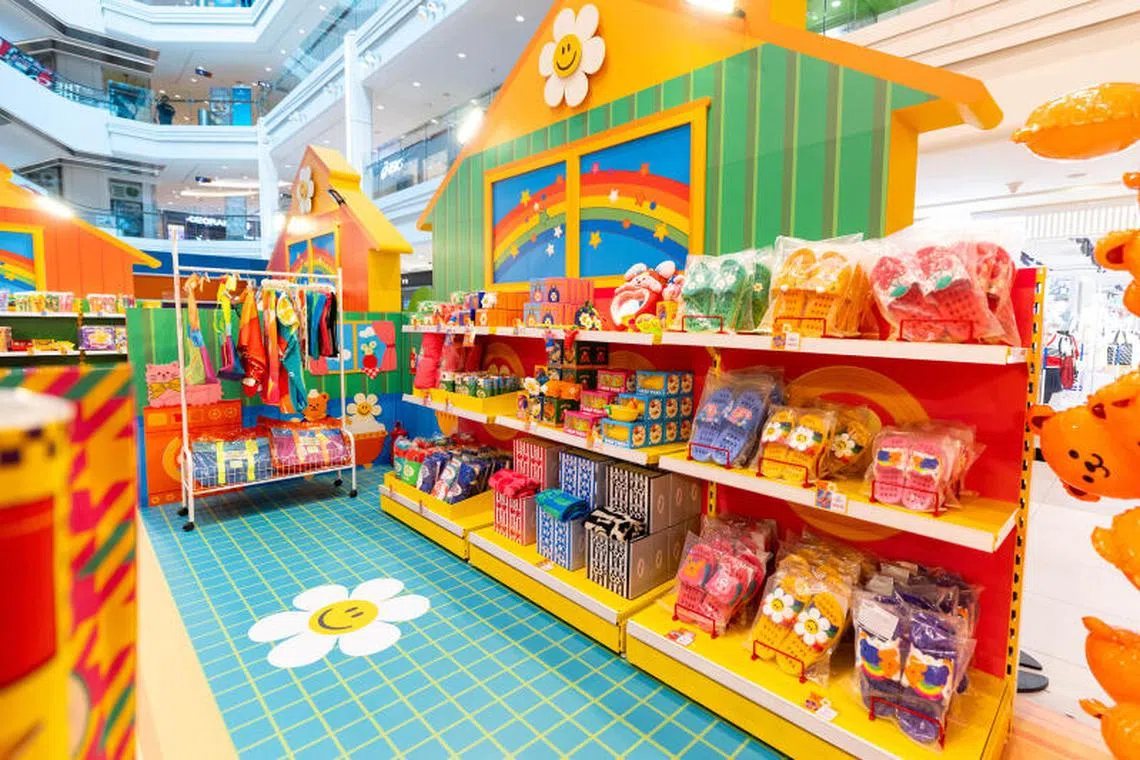[SINGAPORE] In a difficult retail market, landlords of managed Singapore malls are adapting their strategies to the conditions, with moves such as flexible leases, tenant curation and marketing support. But industry players say there is still room to explore new approaches to help retailers cope with changing consumer habits.
High rents have long been a point of contention.
Rent takes up between 10 and 30 per cent of a retailer’s operating costs, said Ernie Koh, president of the Singapore Retailers Association (SRA).
“While landlords seek to maximise returns on their properties, tenants – particularly small businesses – often struggle to keep up with the ever-increasing costs,” he pointed out. “This situation has sparked debates on the sustainability of such pricing models in a highly competitive market, particularly as tourism recovers and rents approach pre-pandemic levels.”
Cushman & Wakefield data showed that prime monthly rent for Orchard malls in 2024 was S$35.83 per square foot (psf), just over the 2019 average of S$35.77 psf. In suburban areas, prime rent had risen to S$32.90 psf last year, from S$31.76 psf in 2019.
For many retailers, especially those in high-traffic or prime locations, the effect of even modest rent increases can snowball into a punishing tide when sales are flat or falling.
A NEWSLETTER FOR YOU
Tuesday, 12 pm
Property Insights
Get an exclusive analysis of real estate and property news in Singapore and beyond.
Major real estate investment trusts (Reits) have reported positive rental reversions, allowing landlords to renew leases or fill spaces at higher rates.
Leading suburban mall player Frasers Centrepoint Trust (FCT) reported positive reversions over the past five years, except in FY2021 when it was negative 0.6 per cent amid Covid disruptions.
In FY2024, FCT’s rental reversion rose to 7.7 per cent from 4.7 per cent in the previous year, with its malls posting positive reversions of 4 to 8.8 per cent, driven by active asset management and strong leasing demand.
CapitaLand Integrated Commercial Trust (CICT), Singapore’s largest landlord with 21 assets, posted an 8.8 per cent rental reversion in FY2024. This meant rents for about 25 per cent of its mall space rose by roughly 3 per cent a year, and overall mall rent increased 0.75 per cent year on year. This was “well within inflation levels”, explained Ervin Yeo, group chief strategy officer and commercial management chief at CapitaLand Investment.
Since 2018, tenant sales per square foot at CapitaLand malls have grown at a compound annual growth rate of 1.9 per cent, outpacing rental growth of 0.7 per cent, he noted.
Speaking with The Business Times, Yeo said that rent adjustments are a “trailing indicator” that surface only at renewal. What matters more, he stressed, is occupancy cost – the ratio of rent to sales – which has stayed below 20 per cent over the past decade for the group’s portfolio of malls.
Still, occupancy cost averages can mask disparities. “Averages can hide struggles in specific tenant segments,” noted RHB analyst Vijay Natarajan. “Landlords need to look at performance more granularly – by trade, category or tenant type – to identify where support or adjustments are needed.”
Recognising these disparities, CICT monitors occupancy costs by trade categories as each business type has different operating models and margins.
“This reflects the rental rebates, marketing support and flexible arrangements we (have) provided to help tenants manage costs,” added Yeo. “Ultimately, our goal is for our tenants to succeed, as their success is integral to the vibrancy and long-term performance of our malls.”
Support measures, tenant curation
A Starhill Global Reit spokesperson pointed out that food and beverage (F&B) tenants, in particular, continue to grapple with rising operational cost, manpower shortage and changing consumer patterns that have weighed on footfall and margins.
“These are industrywide challenges, and probably the best way forward is through a strong landlord-tenant collaboration to achieve a long-term sustainable solution,” the spokesperson added.
Starhill, which owns prime Orchard Road malls Wisma Atria and part of Ngee Ann City, works with underperforming tenants to help grow revenue, including through joint marketing efforts, sharing shopper insights, and operational support to boost visibility and sales.
CapitaLand leverages its scale to help tenants manage costs, including by negotiating bulk electricity rates.
Landlords are also now more intentional in curating their tenant mix, an approach that helps shoppers find what they want and discover new offerings efficiently, said Natarajan.
For instance, clustering F&B options in one area improves navigation, while placing complementary stores near each other – such as a department store next to an electronics store – spurs spending.
A well-curated mall can boost tenant sales, which in turn supports higher rents, he added.
While tourist numbers at Starhill’s malls are rising, spending has slowed, with people spending more on experiences and entertainment – a trend exacerbated by regional economic challenges, said the Reit’s spokesperson.
Wisma Atria, which counts Burberry and Emperor Watch & Jewellery among its luxury tenants, has shifted towards a “more balanced” trade mix, bringing in younger brands such as Vivaia, popular for its machine-washable shoes, and Chinese beauty brand Joocyee.

Since 2024, Frasers has brought on board more than 150 new tenants across its malls, about half of which are retail specialty concepts and the rest in F&B, said Adrian Tan, managing director of retail at Frasers Property Singapore.
New additions in its neighbourhood malls include Sinpopo Coffee at Tampines 1, and Putien Mama and Munchi Pancakes at Tiong Bahru Plaza.
Flexibility in leases
Curating the right mix is just one lever. Landlords are increasingly using flexible lease structures to help retailers find their footing.
“The pandemic played a role in accelerating this shift, as both landlords and tenants faced unforeseen challenges,” said SRA’s Koh. “Flexible leases, which allow for rent adjustments based on foot traffic or sales, are becoming more common in certain retail spaces.”
At CapitaLand, such arrangements have long been part of the toolkit, with some leases shorter in duration and sometimes carrying a higher turnover-rent component, noted Yeo.
“Flexible leases are not meant to replace traditional models, but rather to complement them,” he added. “It allows us to activate underutilised spaces, pilot new concepts and bring in new-to-market brands and fresh retail experiences that enhance shopper engagement and support the asset’s long-term competitiveness.”
Brands such as Beyond The Vines and Omnidesk started as pop-ups and are now permanent at Funan. Coffee bar Alchemist operated as a pop-up for 11 months before moving into a shared space with local fashion label Arcade Clothing at Funan.
Korean lifestyle brand Wiggle Wiggle, which held a pop-up at Plaza Singapura in March, is now exploring longer-term opportunities with CICT, said Yeo.

Frasers also offers shorter-term leases for new and emerging brands. Successful concepts can then transition to standard, longer-term leases, as seen with The JeJe Korea and Mondays Made at The Centrepoint.
“These arrangements extend beyond traditional shop units and apply across a variety of mall spaces, supporting a dynamic retail mix, allowing tenants to adapt and grow in line with evolving shopper preferences,” said Tan.
While flexible leases offer opportunities for experimentation, they are not without risk. Desmond Sim, CEO of real estate consultancy ETC and member of the Fair Tenancy Industry Committee, observed that lease flexibility and rent controls can affect a mall’s valuation.
“Property values depend heavily on the predictability of income during the initial term – typically the first three years – after which the income is capitalised for the remainder of the lease or into perpetuity,” he added. “Regardless of how long your mall has been operating, its value hinges on the stability of its income.”
Yeo said: “As our malls are mostly Reit-owned, maintaining income stability and delivering long-term value for unitholders remain key priorities. We balance lease flexibility with a solid base of long-term tenants to ensure resilience in our rental income.”
What else can be done?
Singapore’s retail sector needs to look beyond traditional high-traffic areas, pointed out SRA’s Koh. Mixed-use developments can offer a more sustainable environment for tenants and ease reliance on high rents.
Landlords can also tap underused mall spaces for pop-ups. Sim noted that retail is now a “very visual and experiential” business, where creative, immersive in-store experiences can drive sales.
CapitaLand has partnered Enterprise Singapore to invite local brands to showcase their most innovative store concepts. Winning concepts will receive up to one year of retail space – up to 4,000 square feet – at malls including Plaza Singapura, CQ @ Clarke Quay, and Funan.
The government can also provide incentives to boost spending at shops selling local brands or at neighbourhood malls, said Natarajan. But broader rent control is not feasible as prices are market-driven.
SRA’s Koh added: “The future of Singapore’s retail sector may rely on a new equilibrium, one that considers not just the interests of landlords but also the sustainability and vibrancy of the tenant ecosystem, ensuring that the retail landscape remains dynamic and diverse for years to come.”




